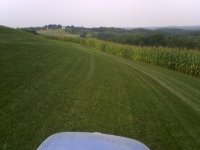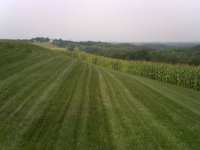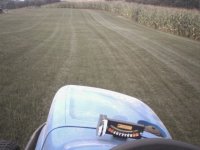scott_vt
Super Member
- Joined
- Oct 5, 2004
- Messages
- 7,440
- Location
- east wells,vt
- Tractor
- 1986 MF 1040, 1942 Farmall A, 1949 Farmall Super A
Superduper said:Two things I would like to chime in on. Firstly, most all newer tractors will comply with one of two specifications: ANSI B71.1 and ANSI B71.4. The former for consumer equipment and the latter for commercial equipment. If you own a small garden tractor, then it probably complies with the former and if you own a CUT, it is probably the latter. The difference is that B71.1 specifies minimum lateral stability of 25 degrees measured at rollover, while B71.4 specifies 20 degrees measured by pulling out test strip (don't ask as I don't know what this means). There is more, of course to the ANSI specification, but this is as far as it is addressed regarding lateral stability. Asking what degree slope is safe is not a good question as this can vary greatly from equipment to equipment, and configuration to configuration. For example, the same tractor can normally be ordered with R1 tires, or R4 tires. Your stability with R1 mounted in a "narrow" configuration for crop row clearance will be much reduced than the same tractor with R4 tires mounted at widest position. Furthermore, as you've already gathered by the other posts, each person's pucker factor varies greatly, just as people's tolerance of heights can vary greatly. The lack of fear doesn't necessarily mean that the situation is safer, merely that one can better cope with it. Also, the longer you mow slopes, the more accustomed you get to it, and this can lead to complacency and misplaced confidence, just as you can be overly cautious when first operating it. Don't get me wrong, the pucker factor is a good thing because it will definitely motivate you to operate at a more cautious and attentive level.
Secondly, the triangle description is an excellent explanation but can be hard to picture. The attached pdf file addresses tractor overturn hazards and center of gravity. Page 2 shows an excellent illustration regarding what point the center of gravity is overcome and tips the tractor. As you can see by the illustration, the tractor that is at the verge of tipping is really tilted quite dramatically and most everyone will admit that they never operate their equipment anywhere close to this angle of operation. Certainly, at the illustrated angle, the operator will have great difficulty just maintaining his rear on the seat and probably needs to hang on dearly. The illustration does show that the center of gravity for the depicted tractor is at a point just above the rear axle. Say we raise the CG for safety sake to a point between the two rear reflectors. Even with that, you can see that the tractor can still be tilted quite dramatically to be well within safe limits. However, as in previous contributions, it is extremely important to operate slowly so as not to introduce dynamic centrifugal forces that can increase the negative effects of center of gravity. Also, operating at the verge of tilt is definitely a no-no as there will be no margin for unexpected ruts and other real life challenges.
Now, if we examine the pictures of the Kubota and NH tractors sitting on the slopes and draw an imaginary vertical line from the center of the headlamps to the ground, we see that the point that the line would contact the ground is well inside of the outside edge of the tires and it would appear that the tractors are well within the level of safe operation. In reality, the center of gravity is probably lower than the headlamps as the headlamps are probably already at the top of the engine, and there is a lot of weight below that point. The low profile of the kubota in particular shows that there is significantly greater room for tilt before getting tippy. Note however, that both operators indicate that their pucker factor is kicking into high gear.
Finally, I was wondering whether someone could comment on whether they feel the attached image depicts a slope that could be easily traversed with their tractor, and a brief description of their tractor?
Mornin Superduper,
Excellent post !!! And thanks for putting fact and physics into a practical application and or approach on tractor operation on hillsides



